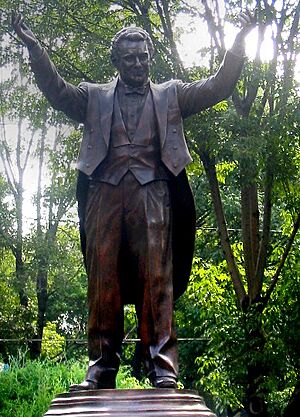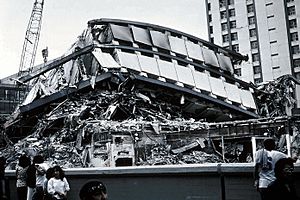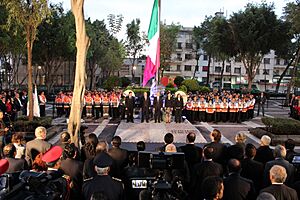1985 Mexico City earthquake facts for kids

Mexico City – Collapsed Hospital Juárez de México
|
|
| UTC time | 1985-09-19 13:17:50 |
|---|---|
| ISC event | 516095 |
| USGS-ANSS | ComCat |
| Local date | 19 September 1985 |
| Local time | 07:17:50 |
| Magnitude | 8.0 Mw |
| Depth | 20 km (12 mi) |
| Epicenter | 18°21′N 102°23′W / 18.35°N 102.39°W |
| Areas affected | Mexico |
| Total damage | Extreme |
| Max. intensity | IX (Violent) |
| Tsunami | 1–3 m |
| Aftershocks | 7.5 Mw 20 September 1985 7.0 Mw 30 April 1986 |
| Casualties | 5,000–45,000 dead 30,000 injured |
The 1985 Mexico City earthquake was a very strong earthquake that hit Mexico City on September 19, 1985. It had a magnitude of 8.1, which is incredibly powerful. This natural disaster caused a lot of damage and led to the loss of many lives. It is remembered as one of the most serious earthquakes in Mexico's history.
Contents
What Happened During the Earthquake?
The main earthquake struck early in the morning, at 7:17 AM. It lasted for several minutes, causing the ground to shake violently. The earthquake's center was off the coast of Mexico, far from Mexico City. However, Mexico City is built on an old lakebed, which made the shaking much worse. The soft soil amplified the earthquake's waves, turning them into giant ripples.
How Strong Was It?
The earthquake measured 8.1 on the Richter scale. To give you an idea, earthquakes above 8.0 are considered "great" earthquakes. They can cause major damage over a very large area. After the main shock, there were also strong aftershocks. One aftershock, measuring 7.5, happened the very next day. Another one, measuring 7.0, occurred in April 1986.
Tsunami and Landslides
Because the earthquake happened near the coast, it also caused a small tsunami. Waves between 1 and 3 meters high were reported along the coast. Luckily, there were no major landslides directly caused by this earthquake.
Impact and Aftermath
The earthquake caused extreme damage, especially in Mexico City. Many buildings, including homes, hospitals, and schools, collapsed or were severely damaged. The city's infrastructure, like roads and power lines, was also badly hit.
Buildings Collapsed
Many buildings in Mexico City were not built to withstand such strong shaking. The soft soil underneath the city made the shaking worse, causing many structures to crumble. For example, parts of the Hospital Juárez de México collapsed, and the Pino Suárez Apartment Complex was also heavily damaged.
People Affected
The human cost of the earthquake was tragic. Estimates of the number of people who died range from 5,000 to 45,000. Around 30,000 people were also injured. Many people were trapped under the rubble of collapsed buildings.
Rescue Efforts and Community Help
After the earthquake, thousands of people, including ordinary citizens, rushed to help. They worked tirelessly to rescue survivors from the debris. International aid also poured into Mexico to assist with the recovery efforts. The earthquake showed the incredible strength and unity of the Mexican people.
Remembering the Event
The 1985 earthquake is a very important event in Mexico's history. It led to big changes in how buildings are constructed in Mexico City. Stricter building codes were put in place to make sure new buildings could withstand future earthquakes. The city also developed better emergency response plans.
Statues and Tributes
There are memorials and statues in Mexico City to remember the victims and heroes of the earthquake. One statue honors the seamstresses who died when their factory collapsed. Another statue recognizes the famous singer Plácido Domingo for his help and contributions to the victims.

Related pages
Images for kids
-
Map showing regional tectonic plates and the Middle America Trench.
See also
 In Spanish: Terremoto de México de 1985 para niños
In Spanish: Terremoto de México de 1985 para niños










